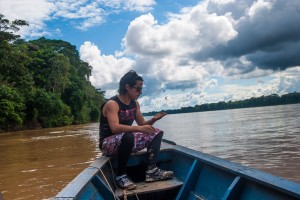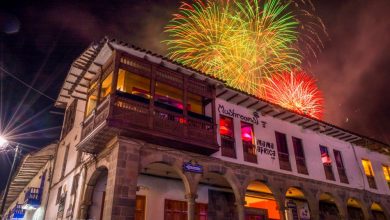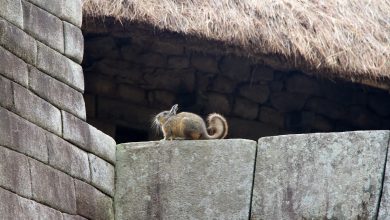
A short flight from Cuzco or a longish but spectacular drive lies a different world, the high Amazon jungle. The main city, although not in Cuzco proper, is called Puerto Maldonado, or MacDonald’s port. Splayed between and around two large rivers, the Tambopata and the larger Madre de Dios, it lies at the heart of region of tourism and economic growth, especially now that a highway connecting the Atlantic and Pacific coasts goes through it.
In the days of the rubber boom in the nineteenth century this area was important to the world and adventurers, profiteers, and migrants poured into it, only to have the economy fall apart when rubber came to be grown on other continents. The ever encroaching jungle reclaimed settlements and the boom condensed into a scattered memory.
Near Puerto Maldonado today is the great and popular Manu national park, as well as the very, very large Tambopata preserve. The region is said to contain an amazing diversity of life, one of the greatest on earth. At the same time, settlers pour down from the Andes seeking to make a living in mining (especially gold), harvesting wildlife, and logging, among other things.
As a result of this, and the international highway, the area near Puerto Maldonado has the feel of boom towns, not unlike what you may have read about in the California, Alaska, and Australian gold rushes. You may drive through a town on stilts above water not far from Puerto Maldonado, that lines the highway. At night all you see is men milling, streetwalkers standing in the bright lights of the highway, and neon signs for inexpensive rooms.
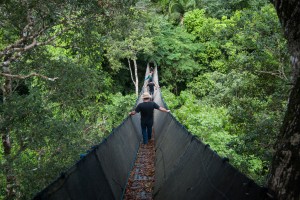
Puerto Maldonado itself is a smallish city of about 200,000, whose plaza and streets vibrate at night. It has the marked feel of a growing jungle post, as well as businesses and restaurants appropriate for an important regional town.

Known for being hot, despite its welcoming spirit, and for its hosts of annoying mosquitos and other stinging bugs that welcome tourists, as well as for the need to bathe frequently during the day. It is also the staging ground for tourism into the Tambopata Preserve and its famous lodges. Although Manu is accessible by boat, the majority of tourists either fly there or descend into the lowlands via a different road than that which takes you to Puerto Maldonado.
To get to the Tambopata and nearby lodges one travels down the enormous Madre de Dios River by boat. Although a huge river by normal standards, this large flow of water is dwarfed as it joins down river the Beni and then Mamore rivers to become the Madeira, one of the great tributaries of the Amazon.
The region of Madre de Dios is so vast and so little inhabited that river travel is the main way of getting between places. Canoes with outboard motors and roofs against the intense tropical sun or even more intense tropical rains ply the river on both sides.
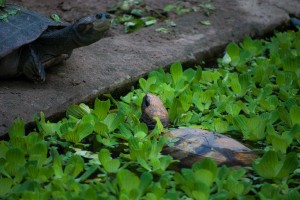
To get to the various lodges you can either go to Puerto Maldonado and contract with a boatman to take you to a lodge or have a reservation with one of the well known eco lodges in the Tambopata park.
The river has a strong and relatively fast flowing current, due to it proximity to the steep Andean slopes from which much of its water has recently dropped. Its bank is lines with intense vegetation behind which you can see the high canopy of the Amazon rainforest. As you chug along to the pulse of the outboard motor, you see entire large trees that have fallen into the water in the recent rainy season with its floods, rare houses on stilts, and more common rustic piers often with canoes tied to them
Recently, we went to Amazon Planet, and ecolodge and private reserve on the Madre de Dios river. It holds 45 hectares of primary and secondary forest and is located on teh right bank of the river within the buffer zone of the Tambopata Reserve.
Our trip to the lodge took almost two hours of river travel with the current. The journey was filled with the excitement of being in the jungle and traveling down this amazing river at the same time the languor of it took a toll.
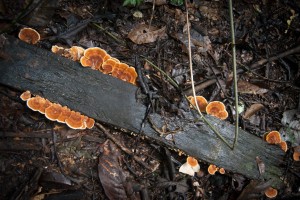
On arrival at Amazon Planet you notice an unremarkable and rustic pier and a faint wooden sign that names the place. You descend from your canoe and climb up the substantial riverbank and past the curtain of vegetation to a surprising grassy park and maybe even the volunteers–students from US and other universities–playing soccer, to go to the restaurant to pay the entrance fee, which includes lunch.
In our case, the boatman was our guide and he took us down well marked but very muddy trails that entered into the jungle. The trails are marked with signs and occasional red ribbons around trees to keep people from getting lost in the ever changing labyrinth of vegetation and sounds.
Not only do you encounter constantly varying vegetation, you also run into a seeming infinite world of insects. The trek requires walking on hanging bridges strung between trees. You can also walk up a long and rising bridge that rises to the top of a canopy where a platform allows you to observe the wildlife at the tops of the trees, since the forest includes numerous levels with different types of life. After a few hours of trekking through the jungle, drenched with sweat, with shoes covered in mud, you return to the lodge via the pens where the Amazon Jungle staff keeps animals who have been recovered from capture and are being rehabilitated for release in the wild.
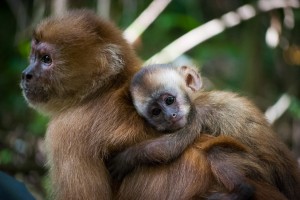
At the lodge you then eat a lunch of local food, with vegetarian offerings for those who require them. The lunch is eaten in a wide, screened room at communal tables. Of note, the restaurant provides a hot sauce of pickled hot peppers known locally as fish eyes. They are red and intense, with fruity notes. The lodge offers jars fo the pickled peppers should you wish to take some home.
After lunch you can enjoy a quick game on the green or relax in hammocks under the shade of large trees.
Then the longer journey abck to Peurto Maldonado begins. The boat seems to trudge against the current and the vegetation and river no longer seem as fresh. Nevertheless, the ride is spectacular especially if you get a sunset over the river on approaching the city with its new, red colored bridge spanning the Madre de Dios River.
The price of our day tour to Amazon Planet was 45/S per person for lunch and access to Amazon Planet and a flat 200/S for the boat.
If you are not a person who has booked a tour well in advance, this is a good and economical option.
